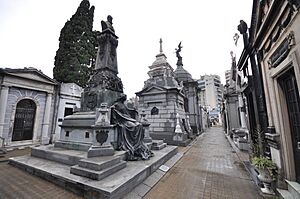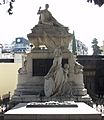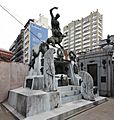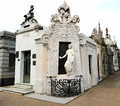La Recoleta Cemetery facts for kids
|
Cementerio de la Recoleta
|
|
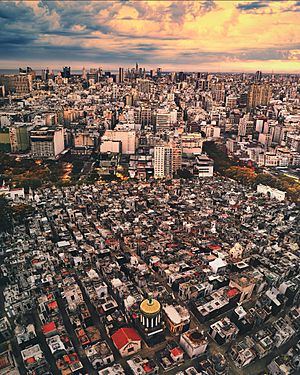
Aerial view of the cemetery
|
|
| Lua error in Module:Location_map at line 420: attempt to index field 'wikibase' (a nil value). | |
| Details | |
|---|---|
| Established | 1822 |
| Location |
Junín 1760, Buenos Aires
|
| Country | Argentina |
| Type | Public |
| Size | 5.5 hectares (14 acres) |
| No. of graves | 4691 vaults |
La Recoleta Cemetery (Spanish: Cementerio de la Recoleta) is a famous cemetery in the Recoleta neighborhood of Buenos Aires, Argentina. It is known for its beautiful and detailed mausoleums. Many important people from Argentina's history are buried here.
Some of these famous people include Eva Perón, who was a First Lady, and several presidents. You can also find Nobel Prize winners and military heroes here. In 2011, the BBC called it one of the world's best cemeteries. Later, in 2013, CNN said it was one of the 10 most beautiful cemeteries globally.
Contents
History of La Recoleta Cemetery
From Convent Garden to Public Cemetery
In the early 1700s, a group of Franciscan Recollect monks came to this area. It was then on the edge of Buenos Aires. The cemetery was built around their convent and a church. This church, called Our Lady of the Pillar, was finished in 1732.
The monks' group was closed down in 1822. The garden of their convent was then turned into the first public cemetery for Buenos Aires. It opened on November 17, 1822. It was first named Cementerio del Norte, meaning "Northern Cemetery."
Key Figures in its Creation
The people who helped create the cemetery were Martin Rodríguez, who was the governor at the time, and his minister Bernardino Rivadavia. Governor Rodríguez was later buried in this very cemetery.
Designing the Cemetery
A French engineer named Próspero Catelin designed the cemetery in 1822. He also designed the front of the Buenos Aires Metropolitan Cathedral. The cemetery was last updated in 1881. This work was done when Torcuato de Alvear was the city's mayor. An Italian architect, Juan Antonio Buschiazzo, led this redesign.
Exploring La Recoleta Cemetery
Layout and Design
The cemetery covers about 5.5 hectares (about 13.6 acres). It has 4,691 vaults, which are all built above the ground. This means no one is buried underground. The Argentine government has named 94 of these vaults as National Historical Monuments. This means they are very important and protected.
The main entrance has grand gates with tall Doric columns. Inside, you will see many detailed marble mausoleums. These are like small buildings for families. They are decorated with statues and come in many different styles. You can see Art Deco, Art Nouveau, Baroque, and Neo-Gothic designs. Most of the building materials, used between 1880 and 1930, came from Paris and Milan.
A City of Tombs
The entire cemetery is set up like a small city. It has wide main paths lined with trees. These paths branch off into smaller sidewalks. These sidewalks are filled with mausoleums. Many wealthy families in Argentina still use these vaults for their loved ones.
While many mausoleums are well-kept, some have fallen into disrepair. You might see some with broken glass or trash. Among the many memorials, you can find art by famous Argentine sculptors. These include Lola Mora and Luis Perlotti. The tomb of Liliana Crociati de Szaszak is especially interesting because of its unique design.
Famous People Buried Here
La Recoleta Cemetery is the final resting place for many important figures. These individuals played key roles in Argentina's history and culture. Here are a few notable people:
- Eva Perón: She was the First Lady of Argentina and a very influential political figure. Her tomb is one of the most visited.
- Domingo Faustino Sarmiento: A former President of Argentina, known for his work in education.
- Julio Argentino Roca: Another former President, a military general who shaped much of Argentina's modern history.
- Bartolomé Mitre: A President, general, and writer. He was very important in Argentina's early years.
- Carlos Saavedra Lamas: He was an academic and politician. He was the first Latin American to win the Nobel Peace Prize.
- Luis Federico Leloir: A biochemist and physician. He was the first Spanish-speaking person to win the Nobel Prize in Chemistry.
- William Brown: An Irish-born admiral. He is known as the founder of the Argentine Navy.
- Juan Manuel de Rosas: A powerful governor of Buenos Aires Province. His body was brought back to Argentina in 1989.
- Raúl Alfonsín: He was the first democratically elected president after a period of military rule.
- José Hernández: A journalist, politician, and poet. He wrote Argentina's national epic, Martín Fierro.
- Mariquita Sánchez de Thompson: A patriot known for her salon and support for independence.
Images for kids
-
Liza Minnelli visiting tomb of First Lady Eva Perón in 1973
-
Tomb of Juan Bautista Alberdi
-
Mausoleum of Nobel Prize laureate Luis Federico Leloir.
-
Tomb of General Miguel Estanislao Soler.
-
Mausoleum of President Nicolás Avellaneda, devised by the aforementioned French sculptor Jules Coutan.
-
Mausoleum of statesman, diplomat, and journalist José Clemente Paz, created by French sculptor Jules Coutan.
-
Mausoleum of President Manuel Quintana
See also
 In Spanish: Cementerio de la Recoleta para niños
In Spanish: Cementerio de la Recoleta para niños


